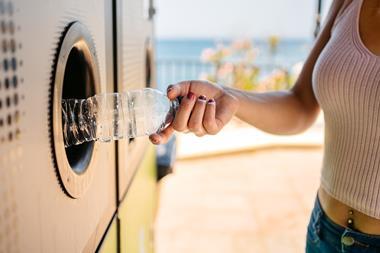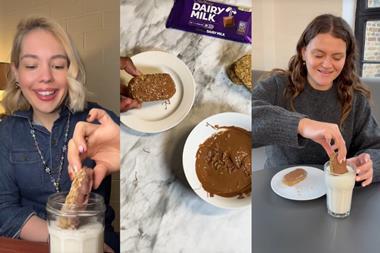Beer and cider aren't just for Christmas. Or for major events like the World Cup. Every year we hear about the importance of getting off-trade right for customers at these times. But the sector has developed to a point where we must develop more sophisticated supplier-retailer partnerships to realise the sector's full potential.
Cider is a classic example of what we can achieve. This category has been the success story of the last two years. Scottish & Newcastle UK has led the pack and we have achieved phenomenal category growth as a result.
But if we are to take cider to even greater heights, we need the co-
operation of retailers. More shelf space will be central to our success. The "premiumisation of cider" extends beyond the "over ice" message and our focus must be on developing leading brands with staying power.
Another key opportunity for 2007 lies in the emerging trend of partnering beer with food. Research suggests that by 2010, 70% of all alcohol drinking occasions will include food. The traditional male beer-drinking session is declining while female buyers are increasingly important to the beer and cider market.
We need to emphasise the importance of siting beer with food, as this will encourage sales while also creating a clear identity for brands. Foster's and the increasingly popular barbecue have been at the cutting edge of this trend. With no major football championship scheduled for next summer, a flexible approach to merchandising and brand support will be essential.
Getting the chilled products right is also a major opportunity. The current availability of chilled beer and cider in-store is poor and this means lost sales potential. Our research proves that if retailers provide a good selection of chilled products, the customers will return to those shops on a regular basis and buy more frequently. Around a fifth of lager buyers and a quarter of cider buyers are also willing to pay more for a chilled product. Providing a cold option builds on customers' enjoyment of the take-home experience. So while suppliers use product design to communicate the consumer benefit, retailers should review their chilled offering.
Finally, retail pricing is a hot potato that is bound to create debate long into the new year. I understand retailers' temptation to use low prices to drive footfall. But for the long-term health of the beer and cider categories, it is essential that we build consumer value without resorting to the easy option of deep discounting. Responsible drinks marketing is the responsibility of both retailers and suppliers, and we need to work more closely together to examine the part that price promotions should play.
S&N UK supports The Drinkaware Trust and will continue to work with customers, trade bodies and other stakeholders on this issue. Retailers can help by emphasising premium offerings and new drinking experiences, rather than simply price. That will encourage suppliers to develop new products and create innovative marketing programmes, adding genuine consumer value to the category.
The alcohol industry is largely self-regulating. It is clearly in all our interests to work together and prove that system can be effective in combating excessive or underage consumption. We can help maintain this status by ensuring that we all play a full and active role in responsible drinks marketing and therefore safeguard the future of the sector.
Cider is a classic example of what we can achieve. This category has been the success story of the last two years. Scottish & Newcastle UK has led the pack and we have achieved phenomenal category growth as a result.
But if we are to take cider to even greater heights, we need the co-
operation of retailers. More shelf space will be central to our success. The "premiumisation of cider" extends beyond the "over ice" message and our focus must be on developing leading brands with staying power.
Another key opportunity for 2007 lies in the emerging trend of partnering beer with food. Research suggests that by 2010, 70% of all alcohol drinking occasions will include food. The traditional male beer-drinking session is declining while female buyers are increasingly important to the beer and cider market.
We need to emphasise the importance of siting beer with food, as this will encourage sales while also creating a clear identity for brands. Foster's and the increasingly popular barbecue have been at the cutting edge of this trend. With no major football championship scheduled for next summer, a flexible approach to merchandising and brand support will be essential.
Getting the chilled products right is also a major opportunity. The current availability of chilled beer and cider in-store is poor and this means lost sales potential. Our research proves that if retailers provide a good selection of chilled products, the customers will return to those shops on a regular basis and buy more frequently. Around a fifth of lager buyers and a quarter of cider buyers are also willing to pay more for a chilled product. Providing a cold option builds on customers' enjoyment of the take-home experience. So while suppliers use product design to communicate the consumer benefit, retailers should review their chilled offering.
Finally, retail pricing is a hot potato that is bound to create debate long into the new year. I understand retailers' temptation to use low prices to drive footfall. But for the long-term health of the beer and cider categories, it is essential that we build consumer value without resorting to the easy option of deep discounting. Responsible drinks marketing is the responsibility of both retailers and suppliers, and we need to work more closely together to examine the part that price promotions should play.
S&N UK supports The Drinkaware Trust and will continue to work with customers, trade bodies and other stakeholders on this issue. Retailers can help by emphasising premium offerings and new drinking experiences, rather than simply price. That will encourage suppliers to develop new products and create innovative marketing programmes, adding genuine consumer value to the category.
The alcohol industry is largely self-regulating. It is clearly in all our interests to work together and prove that system can be effective in combating excessive or underage consumption. We can help maintain this status by ensuring that we all play a full and active role in responsible drinks marketing and therefore safeguard the future of the sector.


















No comments yet